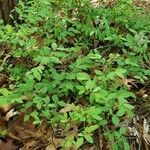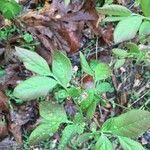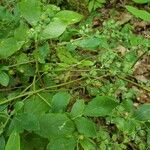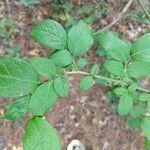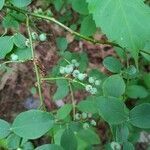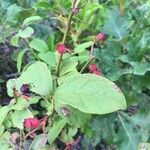Plants forming small to extensive, open colonies, 0.8-10 dm; twigs green, glaucous, or yellow, ± angled, hairy in lines, often glabrous. Leaves deciduous; blade pale green or glaucous abaxially, dark green adaxially, ovate to broadly elliptic, 25-38 × 13-22 mm, membranous to subcoriaceous, margins ± entire, abaxial surface usually glabrous, rarely hairy, eglandular. Flowers: calyx green, glaucous, glabrous; corolla greenish white with pink striping, cylindro-urceolate, 4-10 mm; filaments ± glabrous. Berries usually blue, glaucous, 4-8 mm diam., glabrous. Seeds 5-20, ca. 1 mm. 2n = 24, 48.
A shrub. It loses its leaves. It grows 10-70 cm high. The stems are twiggy and angular. They can be green or yellow. The leaves are oval and 3-4 cm long by 1-2 cm wide. They can have teeth along the edge. The leaves can be pale green or dark blue-green. The flowers are greenish-white with pink stripes. The fruit are blue berries. They are edible.
